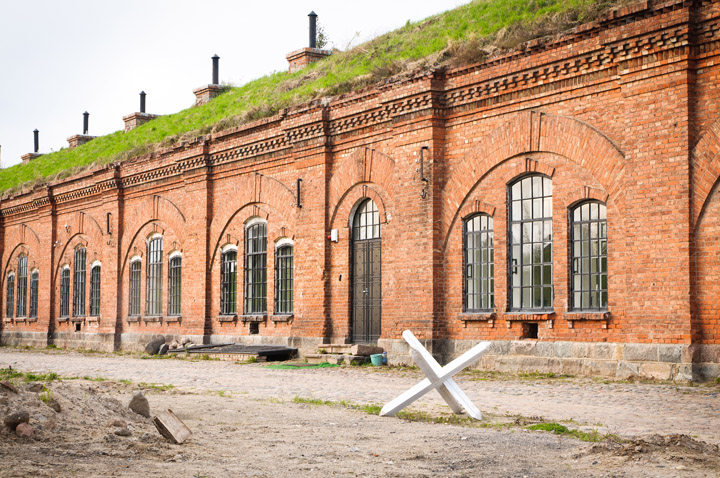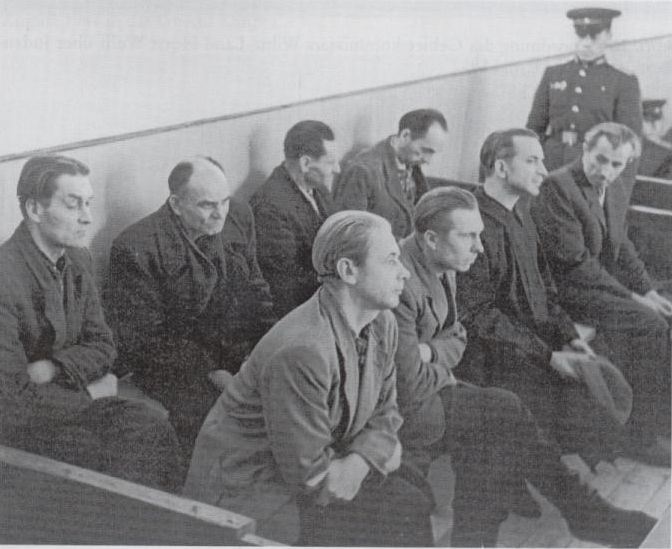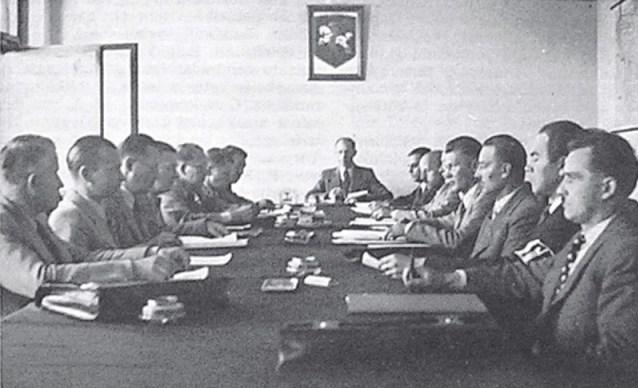|
Kaunas Fortress Seventh Fort
The Seventh Fort or VII Fort is a defensive fortification built in Žaliakalnis district of Kaunas, Lithuania, during implementation of the first phase of the construction of the Kaunas Fortress. It is located near the Hospital of Lithuanian University of Health Sciences. This Fort became the last brick fortification of Kaunas Fortress. The Seventh Fort is close to the central defenses and it is located in the rear of Kaunas Fortress. The first owner of fort was the 11th company of Kaunas Fortress Artillery (Imperial Russian Army). In 1915, German Army occupied the Fort without resistance. The Seventh Fort is one of the best surviving examples of a two-rampart fort, showing the typical design of a 19th-century Russian brick fort. Many authentic elements survive, such as iron window frames, ammunition warehouse gate fragments. During the Fort's restoration, a number of authentic interior details (interior decoration, paving, fittings of ammunition storage doors and gate) were found ... [...More Info...] [...Related Items...] OR: [Wikipedia] [Google] [Baidu] |
Casemate
A casemate is a fortified gun emplacement or armored structure from which artillery, guns are fired, in a fortification, warship, or armoured fighting vehicle.Webster's New Collegiate Dictionary When referring to Ancient history, antiquity, the term "casemate wall" means a double city wall with the space between the walls separated into chambers, which could be filled up to better withstand battering rams in case of siege (see #Antiquity: casemate wall, Antiquity: casemate wall). In its original early modern meaning, the term referred to a vaulted chamber in a fort, which may have been used for storage, accommodation, or artillery which could fire through an opening or embrasure. Although the outward faces of brick or masonry casemates proved vulnerable to advances in artillery performance, the invention of reinforced concrete allowed newer designs to be produced well into the 20th century. With the introduction of ironclad warships, the definition was widened to include a prot ... [...More Info...] [...Related Items...] OR: [Wikipedia] [Google] [Baidu] |
Standartenführer
__NOTOC__ ''Standartenführer'' (short: ''Staf'', , ) was a Nazi Party (NSDAP) paramilitary rank that was used in several NSDAP organizations, such as the SA, SS, NSKK and the NSFK. First founded as a title in 1925, in 1928 it became one of the first commissioned NSDAP ranks and was bestowed upon those SA and SS officers who commanded a unit known as a '' Standarte'' (plural ''Standarten''), a unit equivalent to an army battalion and comprising 300–500 personnel. In 1929 the rank of ''Standartenführer'' was divided into two separate ranks known as ''Standartenführer'' (I) and ''Standartenführer'' (II). This concept was abandoned in 1930 when both the SA and SS expanded their rank systems to allow for more officer positions and thus the need for only a single ''Standartenführer'' rank. In 1933, when Adolf Hitler came to national power in Germany, the rank of ''Standartenführer'' had been established as the highest field officer rank, lower than that of ''Oberführer'' ... [...More Info...] [...Related Items...] OR: [Wikipedia] [Google] [Baidu] |
Schutzstaffel
The ''Schutzstaffel'' (SS; also stylized as ''ᛋᛋ'' with Armanen runes; ; "Protection Squadron") was a major paramilitary organization under Adolf Hitler and the Nazi Party in Nazi Germany, and later throughout German-occupied Europe during World War II. It began with a small guard unit known as the ''Saal-Schutz'' ("Hall Security") made up of party volunteers to provide security for party meetings in Munich. In 1925, Heinrich Himmler joined the unit, which had by then been reformed and given its final name. Under his direction (1929–1945) it grew from a small paramilitary formation during the Weimar Republic to one of the most powerful organizations in Nazi Germany. From the time of the Nazi Party's rise to power until the regime's collapse in 1945, the SS was the foremost agency of security, surveillance, and terror within Germany and German-occupied Europe. The two main constituent groups were the '' Allgemeine SS'' (General SS) and ''Waffen-SS'' (Armed SS). The ' ... [...More Info...] [...Related Items...] OR: [Wikipedia] [Google] [Baidu] |
Tautinio Darbo Apsaugos Batalionas
The Lithuanian TDA Battalions ( lt, Tautinio darbo apsaugos batalionas) or TDA, were paramilitary units organized in June–August 1941 by the Provisional Government of Lithuania at the onset of Operation Barbarossa. Members of the TDA were known by many names such as Lithuanian auxiliaries, policemen, white-armbands, nationalists, rebels, partisans, or resistance fighters. TDA was intended as basis for the future independent Lithuanian Army, but soon it was taken over by Nazi officials and reorganized into the Lithuanian Auxiliary Police Battalions (Lithuanian version of ''Schutzmannschaft''). The original TDA eventually became the 12th and the 13th Police Battalions. These two units took an active role in the Holocaust, mass killings of the Jews in Lithuania and Belarus. Based on the Jäger Report, members of TDA murdered about 26,000 Jews between July and December 1941. Formation As Nazi Germany declared war on the Soviet Union and invaded Lithuania, the Provisional Government of ... [...More Info...] [...Related Items...] OR: [Wikipedia] [Google] [Baidu] |
Lithuanian Provisional Government
The Provisional Government of Lithuania ( lt, Laikinoji Vyriausybė) was a temporary government aiming for independent Lithuania during the last days of the first Soviet occupation and the first months of German Nazi occupation in 1941. It was secretly formed on 22 April 1941, announced on 23 June 1941, and dissolved on 5 August 1941. It was formed from the members of the Lithuanian Activist Front (LAF) in Kaunas and Vilnius. History The provisional government was confirmed on 22 June, 1941 at the start of the June uprising. However, the leader of the LAF, Kazys Škirpa, who was supposed to become the prime minister, was in Germany at the time, hoping to obtain recognition for Lithuania (he was also former Lithuanian envoy to Germany and therefore continued to reside there). Since the Nazi regime saw Lithuania as a future part of Greater Germany, it was not much interested in Lithuanian independence, but allowed the Provisional Government to operate while it was useful. ... [...More Info...] [...Related Items...] OR: [Wikipedia] [Google] [Baidu] |
Jews Of Lithuania
Jews ( he, יְהוּדִים, , ) or Jewish people are an ethnoreligious group and nation originating from the Israelites Israelite origins and kingdom: "The first act in the long drama of Jewish history is the age of the Israelites""The people of the Kingdom of Israel and the ethnic and religious group known as the Jewish people that descended from them have been subjected to a number of forced migrations in their history" and Hebrews of historical History of ancient Israel and Judah, Israel and Judah. Jewish ethnicity, nationhood, and religion are strongly interrelated, "Historically, the religious and ethnic dimensions of Jewish identity have been closely interwoven. In fact, so closely bound are they, that the traditional Jewish lexicon hardly distinguishes between the two concepts. Jewish religious practice, by definition, was observed exclusively by the Jewish people, and notions of Jewish peoplehood, nation, and community were suffused with faith in the Jewish God, ... [...More Info...] [...Related Items...] OR: [Wikipedia] [Google] [Baidu] |
Operation Barbarossa
Operation Barbarossa (german: link=no, Unternehmen Barbarossa; ) was the invasion of the Soviet Union by Nazi Germany and many of its Axis allies, starting on Sunday, 22 June 1941, during the Second World War. The operation, code-named after Frederick Barbarossa ("red beard"), a 12th-century Holy Roman emperor and German king, put into action Nazi Germany's ideological goal of conquering the western Soviet Union to repopulate it with Germans. The German aimed to use some of the conquered people as forced labour for the Axis war effort while acquiring the oil reserves of the Caucasus as well as the agricultural resources of various Soviet territories. Their ultimate goal was to create more (living space) for Germany, and the eventual extermination of the indigenous Slavic peoples by mass deportation to Siberia, Germanisation, enslavement, and genocide. In the two years leading up to the invasion, Nazi Germany and the Soviet Union signed political and economic pacts for st ... [...More Info...] [...Related Items...] OR: [Wikipedia] [Google] [Baidu] |
Nazi-occupied Europe
German-occupied Europe refers to the sovereign countries of Europe which were wholly or partly occupied and civil-occupied (including puppet governments) by the military forces and the government of Nazi Germany at various times between 1939 and 1945, during and shortly before World War II, generally administered by the Nazi regime, under the dictatorship of Adolf Hitler.Encyclopædia Britannica German occupied Europe.World War II. Retrieved 1 September 2015 from the Internet Archive. The German Wehrmacht occupied European territory: * as far east as the town of Mozdok in the North Caucasus in the Soviet Union (1942–1943) * as far north as the settlement of Barentsburg in Svalbard in the Kingdom of Norway * as far south as the island of Gavdos in the Kingdom of Greece * as far west as the island of Ushant in the French Republic Outside of Europe proper, German forces effectively controlled areas of North Africa in Egypt, Libya, and Tunisia at times between 1941 and 1943. Ger ... [...More Info...] [...Related Items...] OR: [Wikipedia] [Google] [Baidu] |
Concentration Camp
Internment is the imprisonment of people, commonly in large groups, without charges or intent to file charges. The term is especially used for the confinement "of enemy citizens in wartime or of terrorism suspects". Thus, while it can simply mean imprisonment, it tends to refer to preventive confinement rather than confinement ''after'' having been convicted of some crime. Use of these terms is subject to debate and political sensitivities. The word ''internment'' is also occasionally used to describe a neutral country's practice of detaining belligerent armed forces and equipment on its territory during times of war, under the Hague Convention of 1907. Interned persons may be held in prisons or in facilities known as internment camps (also known as concentration camps). The term ''concentration camp'' originates from the Spanish–Cuban Ten Years' War when Spanish forces detained Cuban civilians in camps in order to more easily combat guerrilla forces. Over the following ... [...More Info...] [...Related Items...] OR: [Wikipedia] [Google] [Baidu] |
Vladimiras Dubeneckis
Vladimiras Dubeneckis (6 September 1888 – 10 August 1932) was a Lithuanian architect and painter. He studied at the Imperial Academy of Arts under Leon Benois, and became a professor of the academy in 1917. He was also a professor at the Kaunas Art School. See also *List of Lithuanian painters A list of notable Lithuanian artists. __NOTOC__ A * Kazys Abromavičius (b. 1928) * Gediminas Akstinas (b. 1961) *Romualdas Aleliūnas (1960-2016) * Zita Alinskaitė-Mickonienė (b. 1939) *Viktoras Andriušis (1908-1967) * Aleksas Andriuškevič ... References 1888 births 1932 deaths 20th-century Lithuanian painters Burials at Petrašiūnai Cemetery {{Lithuania-painter-stub ... [...More Info...] [...Related Items...] OR: [Wikipedia] [Google] [Baidu] |
Lithuanian Central Archive
Lithuanian may refer to: * Lithuanians * Lithuanian language * The country of Lithuania * Grand Duchy of Lithuania * Culture of Lithuania * Lithuanian cuisine * Lithuanian Jews as often called "Lithuanians" (''Lita'im'' or ''Litvaks'') by other Jews, sometimes used to mean Mitnagdim See also * List of Lithuanians This is a list of Lithuanians, both people of Lithuanian descent and people with the birthplace or citizenship of Lithuania. In a case when a person was born in the territory of former Grand Duchy of Lithuania and not in the territory of modern ... {{disambig Language and nationality disambiguation pages ... [...More Info...] [...Related Items...] OR: [Wikipedia] [Google] [Baidu] |






.jpg)


